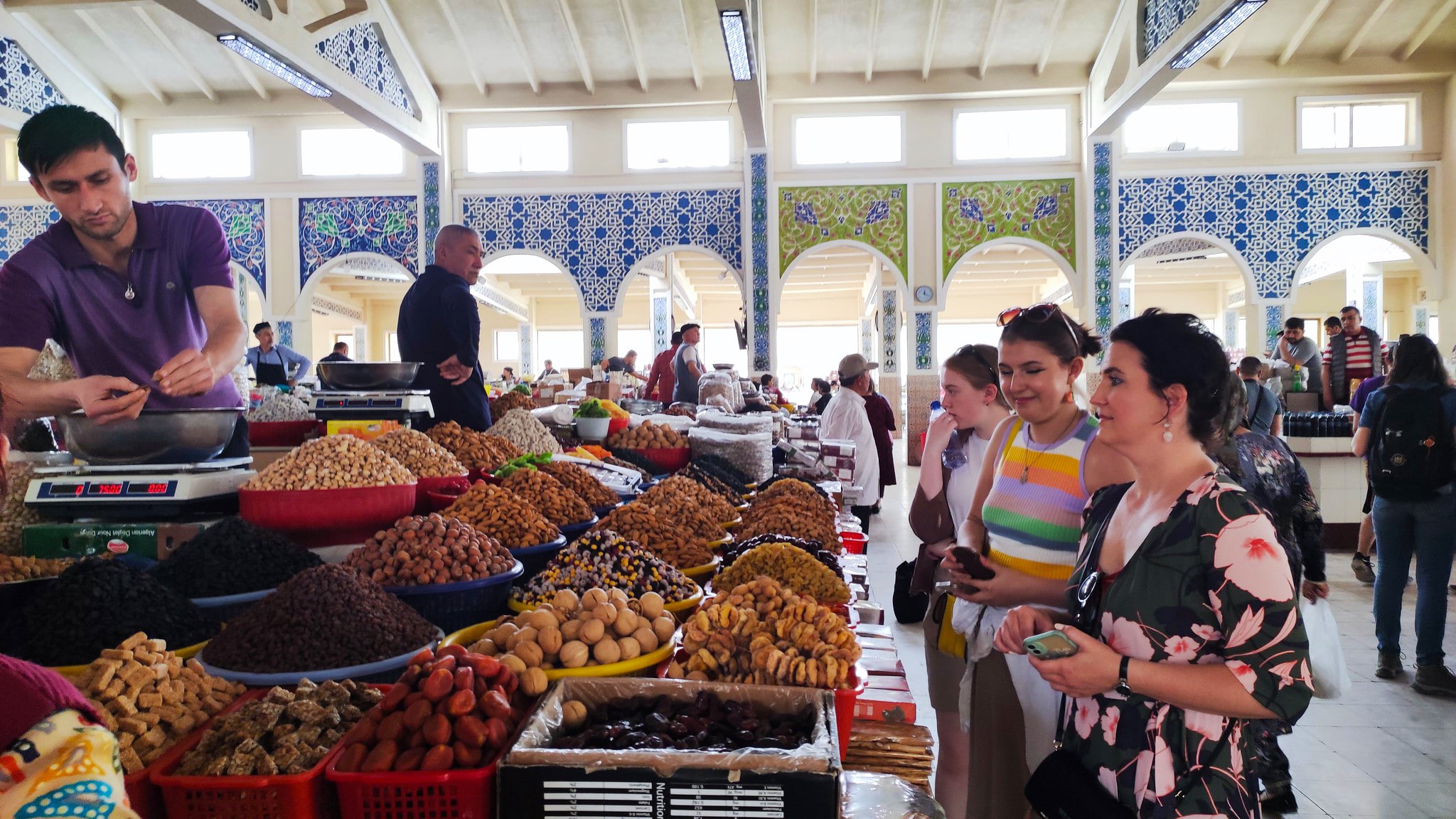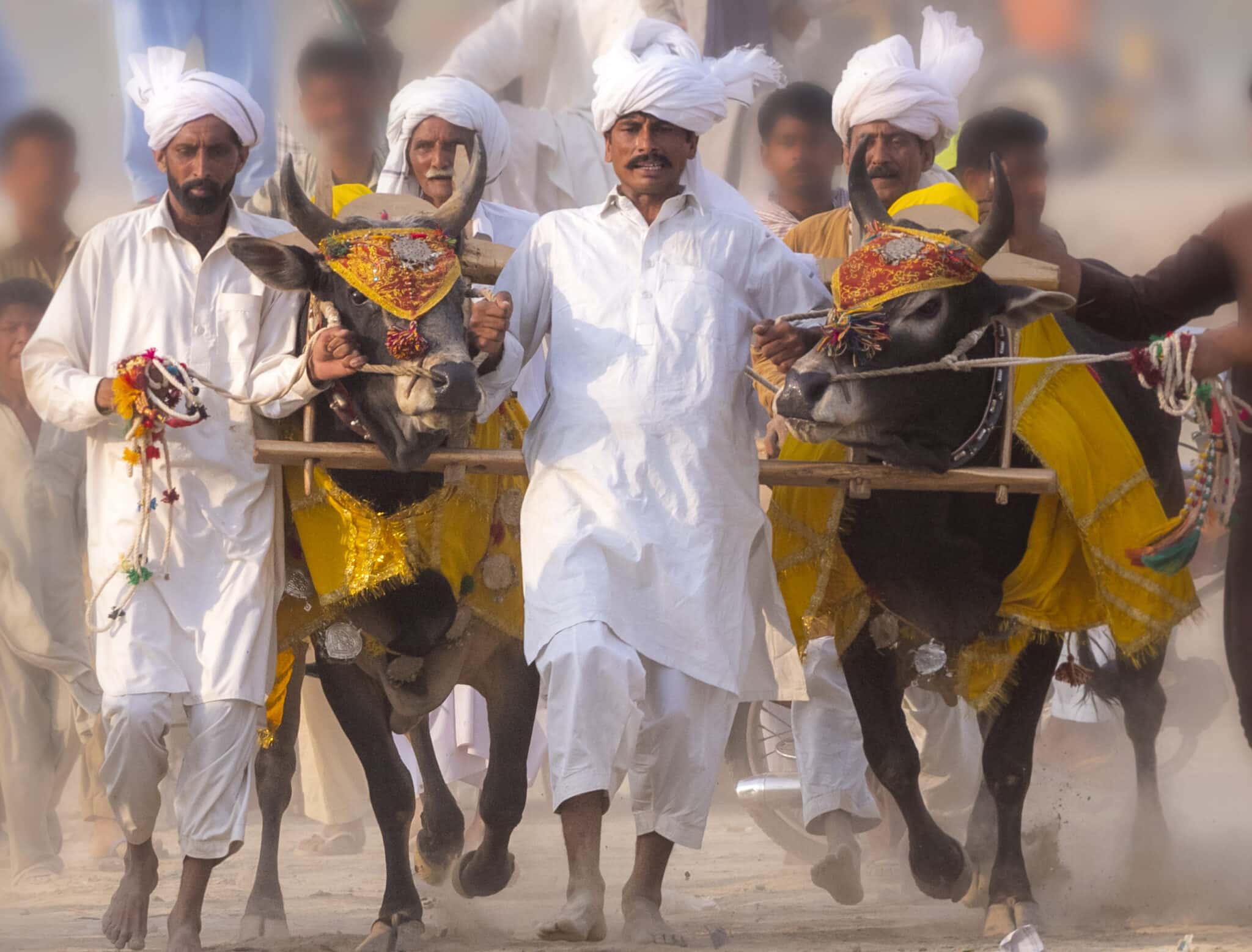The Talking Phrasebook Series presents useful phrases and words in side-by-side translation and with audio files specifically geared to help students work on listening skills and pronunciation. Each entry below, divided by category, features an English word or phrase in the left column and its Punjabi translation in the right, presented in the original Punjabi (below) and with an English-friendly transliteration (above).
Punjabi is an Indo-Aryan language and the most widely-spoken language of Pakistan. UNESCO includes northern and central Pakistan in its definition of Central Asia due to geographic, cultural, historical connections with other Central Asian civilizations. Punjabi has about 80.5 million native speakers in Pakistan and more than 100 million worldwide.
In the center column for each row is a play button. The recorded file will feature first English, then the Punjabi in three versions: one slow, one with each syllable broken out, and a last version that will be spoken as it might be overheard in a conversation between native speakers.
About Punjabi Grammar
- Formality: Punjabi uses a formal/informal system for “you” pronouns, differentiating between a formal “you” with ਤੁਸੀਂਂ (tussi) and an informal “you” with ਤੂੰ (tu). Verbs, however, do not conjugate differently for these two pronouns.
- Gender: Pronouns and verb conjugations vary based on whether a man or woman is speaking. For example, in the phrase “do you speak English?” the verb “to speak” changes into either “bolda” if a man is speaking or “boldee” if a woman is speaking. (Tu Angrezi bolda/boldee (m/f) hain?). Punjabi does not gender inanimate objects.
- Articles: Punjabi does not use articles like a/an/the in English.
- Alphabet: The Punjabi alphabet is called Shahmukhi in Pakistan and Gurmukhi in India, and has been in use for more than 500 years.
- Phonetics: The Punjabi language contains 41 letters (as opposed to the 26 letters in English). This is in part because Shahmukhi is a phonetic alphabet and, where English will combine two letters to create a new sound, Punjabi has unique characters for each sound. Different characters will also be used depending on if a sound is more or less aspirated (with breath at the end) or stressed. For instance, “ਤ” is a softer “t” sound, like in “Tim” while “ਟ” is a hard “t” sound, as in “Tom.” Some sounds are also unique to Punjabi – with no real English equivalents. For instance, “ਞ” is pronounced something like “nj,” “ ਣ” is like a “n” sound, but with the tip of the tongue touching the back palette of the mouth, and “ਭ” producing an aspirated “b” sound somewhat similar to “bha.”
- Capitalization and Punctuation: Punjabi does not traditionally utilize capitalization or punctuation marks, aside from |, which serves the function of a period. That said, punctuation as found in English is a quite common sight in Punjabi nowadays in part due to it being available on computer keyboards and because it makes expressing emotion in written Punjabi easier. So, for example, high literature and religious texts in Punjabi do not typically utilize punctuation marks, but emails and translations often do, although its use is a stylistic choice. We have used them in this resource, for instance.
- Cases and Pronouns: Punjabi utilizes the nominative, accusative, and possessive case systems only for personal pronouns. Nouns, as in English, are not declined for these cases.
Nominative
| I: Main | We: Assi |
| You: Tu | You (formal): Tussi |
| He/She/it: Oh/Onne | They: Oh |
Accusative
| I: Mere | We: Saanu |
| You: Tene | You (formal/plural): Tuhanu |
| He/She/it: Odi/Onnu | They: Onne |
Possessive
| I: Mera/Meri (m/f) | We: Sadda/Saddi (m/f) |
| You: Tuhada/Tuhadi (m/f) | You (formal): Tuhada/Tuhadi (m/f) |
| He/She/it: Usda/Usdi (m/f) | They: Uhna Da/Uhna Di (m/f) |
Survival Basics in Punjabi
| Hi! | Salam! (ਸਲਾਮ!) (used by all speakers) |
|
| Hello! | Sat sri akaal! (ਸਤਿ ਸ੍ਰੀ ਅਕਾਲ!) (used by Punjabi Sikhs, but acceptable to address anyone) |
|
| Hello! | Salam alaikuml! (ਸਲਾਮ ਅਲੈਕੁਮ!) (Used by Punjabi Muslims, but acceptable to address anyone) |
|
| Yes | Hanji (ਹਾਂਜੀ) |
|
| No | Nahi (ਨਹੀਂ) |
|
| Good morning/afternoon/evening! | *Punjabi speakers don’t greet each other with this phrase in Punjabi. Greetings don’t tend to reference the time of day. | |
| What’s up? | Ki haal hain? (ਕੀ ਹਾਲ ਹੈ?) |
|
| How are things? | Sab kuch kidda hain? (ਸਭ ਕੁਛ ਕਿਦਾਂ ਹੈ?) |
|
| How are you? | Tussi kiddha ho? (formal) (ਤੁਸੀਂ/ਤੂੰ ਕਿਦਾ ਹੋ?) |
|
| Good, thank you, and you? | Main theek haan, thanvad, te tussi (formal) (ਮੈਂ ਠੀਕ ਹਾਂ, ਧੰਨਵਾਦ, ਤੇ ਤੁਸੀਂ/ਤੂੰ?) |
|
| Good bye! | Khuda hafiz! (ਖੁਦਾ ਹਾਫਿਜ਼!) (used by Punjabi Muslims, but acceptable to address anyone) |
|
| Good bye! | Rab rakha! (alternative) (ਰਬ ਰਾਖਾ!) (used by Punjabi Sikhs, but acceptable to address anyone) |
|
| See you later! | Phir milde haan! (ਫਿਰ ਮਿਲਦੇ ਹਾਂ!) |
|
| Sorry! | Maaf karna! (ਮਾਫ਼ ਕਰਨਾ!) |
|
| Open/closed | Khulaa/Bandh (“1�ੁੱਲ੍ਹਾ/ਬੰਦ) |
|
| Pull/push | Khicho/Thakha (ਖਿੱਚੋ/ਧੱਕਾ) *when referring to a door |
|
| Small/big | Chota/Vada (ਛੋਟਾ/ਵੱਡਾ) |
|
| Do you speak English? | Tussi Angrezi bolde ho? (formal) (ਤੁਸੀਂਂ ਅੰਗ੍ਰੇਜ਼ੀ ਬੋਲਦੇ ਹੋ?) |
|
| Do you speak English? | Tu Angrezi bolda/boldee (m/f) hain? (ਤੂੰ ਅੰਗ੍ਰੇਜ਼ੀ ਬੋਲਦਾ/ਬੋਲਦੀ ਹੈ?) |
|
| I don’t speak English. | Main Angrezi nahi bolda/boldi. (m/f) ਮੈਂ ਅੰਗਰੇਜ਼ੀ ਨਹੀਂ ਬੋਲਦਾ/ਬੋਲਦੀ |
|
| I only speak a little Punjabi. | Main thoree jayhee Punjabi bolda/boldi (m/f) haan. (ਮੈਂ ਥੋੜੀ ਜੇਹੀ ਪੰਜਾਬੀ ਬੋਲਦਾ/ਬੋਲਦੀ ਹਾਂ) |
|
| I understand. | Main samajdha/samajdhee (m/f) haan. (ਮੈਂ ਸੱਮਝਦਾ/ਸੱਮਝਦੀ ਹਾਂ) |
|
| I don’t understand. | Mainu samajh nahi aunda/aundi. (m/f) (ਮੈਨੂੰ ਸਮਝ ਨਹੀਂ ਆਉਂਦਾ/ਆਉਂਦੀ) |
|
| Thank you!/Thank you very much! | Thanvaad/Bahot thanvaad! (ਧੰਨਵਾਦ/ਬਹੁਤ ਧੰਨਵਾਦ) |
|
| Very well, thanks! | Bahot vadiya, thanvaad! (ਬਹੁਤ ਵਧੀਆ, ਧੰਨਵਾਦ!) |
|
| Well/poor | Theek/Marra (ਠੀਕ/ਮਾੜਾ) |
|
| Good/bad | Changa/Changi (m/f) (ਚੰਗਾ/ਚੰਗੀ)Burra/Burri (m/f) (ਬੁਰਾ/ਬੁਰੀ) |
|
| Please | Kirpa karke (ਕ੍ਰਿਪਾ ਕਰਕੇ )*This phrase is used formally. When speaking informally, it is more common to say “Please” in English. |
|
| You’re welcome! | Tuhada svaagat hai! (ਤੁਹਾਡਾ ਸਵਾਗਤ ਹੈ!) |
|
| No worries! | Koi fikar nahi! (ਕੋਈ ਚਿੰਤਾ ਨਹੀਂ) |
|
| Excuse me! | Mainu maaf karo! (ਮੈਨੂੰ ਮਾਫ਼ ਕਰੋ!) |
|
| A little | Thora jayha (ਥੋੜ੍ਹਾ ਜਿਹਾ) |
|
| Could you speak more slowly? | Tussi thora hauli bol sakde ho? (formal) (ਤੁਸੀਂ/ਤੂੰ ਥੋੜਾ ਹੌਲੀ ਬੋਲ ਸਕਦੇ ਹੋ?) |
|
| Could you repeat, please? | Tussi dubaara kehe sakde ho, kirpa karke? (formal) (ਤੁਸੀਂ/ਤੂੰ ਦੁਬਾਰਾ ਕਹਿ ਸਕਦੇ ਹੋ, ਕਿਰਪਾ ਕਰਕੇ?) |
|
| Could you write that down? | Kee tussi isnu likh sakde ho? (formal) (ਕੀ ਤੁਸੀਂ/ਤੂੰ ਇਸਨੂੰ ਲਿਖ ਸਕਦੇ ਹੋ?) |
|
| My bag/wallet/passport was stolen | Mera/Meri (m/f) bag/batua/passport choree ho geya see (ਮੇਰਾ/ਮੇਰੀ ਬੈਗ/ਬਟੂਆ/ਪਾਸਪੋਰਟ ਚੋਰੀ ਹੋ ਗਿਆ ਸੀ). |
|
| I need a doctor! | Mainu ek doctor di lorr hai! (ਮੈਨੂੰ ਇੱਕ ਡਾਕਟਰ ਦੀ ਲੋੜ ਹੈ!) |
|
| Call the police! | Police nu bulao! (ਪੁਲਸ ਨੂੰ ਬੁਲਾਓ!) |
Introductions in Punjabi
| What is your name? | Tuhada naam ki hai? (formal (ਤੁਹਾਡਾ/ਤੇਰਾ ਨਾਮ ਕੀ ਹੈ?) |
|
| Pleased to meet you! | Tuhaanu mil ke khushi hoi! (ਤੁਹਾਨੂੰ ਮਿਲ ਕੇ ਖੁਸ਼ੀ ਹੋਈ!) |
|
| I am 25 years old. | Mera/Meri (m/f) umar pachi saal hai. (ਮੇਰਾ/ਮੇਰੀ ਉਮਰ ਪੱਚੀ ਸਾਲ ਹੈ) |
|
| How old are you? | Tuhada umar ki hai? (formal)(ਤੁਹਾਡੀ/ਤੇਰਾ ਉਮਰ ਕੀ ਹੈ?) | |
| Where are you from? | Tussi kitho ho? (formal) (ਤੁਸੀ/ਤੂੰ ਕਿੱਥੋ ਹੋ?) |
|
| I am American. | Main Amreekan haan. (ਮੈਂ ਅਮਰੀਕਨ ਹਾਂ) |
|
| No, I am from Canada. | Nahi, main Kaneyda to haan. (ਨਹੀਂ, ਮੈਂ ਕੈਨੇਡਾ ਤੋਂ ਹਾਂ) |
|
| She is Australian. | Oh Australian hai. (ਉਹ ਆਸਟ੍ਰੇਲੀਅਨ ਹੈ) |
|
| He is Irish. | Oh Irish hai. (ਉਹ ਆਇਰਿਸ਼ ਹੈ) |
|
| We are from New Zealand. | Assi New Zealand to haan. (ਅਸੀਂ ਨਿਊਜ਼ੀਲੈਂਡ ਤੋਂ ਹਾਂ) |
|
| They are from Wales. | Oh Wales to hun. (ਉਹ ਵੇਲਜ਼ ਤੋਂ ਹਨ) |
|
| How do you like Punjab? | Tussi Punjab nu keevey pasand kardey ho? (formal) (ਤੁਸੀਂ/ਤੂੰ ਪੰਜਾਬ ਨੂੰ ਕਿਵੇਂ ਪਸੰਦ ਕਰਦੇ ਹੋ?) |
|
| I like Punjab very much. | Mainu Punjab bahot pasand hai. (ਮੈਨੂੰ ਪੰਜਾਬ ਬਹੁਤ ਪਸੰਦ ਹੈ) |
|
| Have you ever been to Lahore? | Tussi kadey Lahore gaye ho? (formal) (ਤੁਸੀਂ/ਤੂੰ ਕਦੇ ਲਾਹੌਰ ਗਏ ਹੋ) |
|
| I have never been to Karachi before. | Main pehla kadey vee Karachi nahi geya. (ਮੈਂ ਪਹਿਲਾਂ ਕਦੇ ਵੀ ਕਰਾਚੀ ਨਹੀਂ ਗਿਆ) |
|
| This is my second time in Punjab. | Eh mera/meri (m/f) Punjab vich dooji vaar hai. (ਇਹ ਮੇਰਾ/ਮੇਰੀ ਪੰਜਾਬ ਵਿੱਚ ਦੂਜੀ ਵਾਰ ਹੈ) |
|
| What do you do? | Tussi ki kardey ho? (formal) (ਤੁਸੀਂ/ਤੂੰ ਕੀ ਕਰਦੇ ਹੋ?) |
|
| I am a student/businessman/teacher/doctor. | Main ek vidyarthi/karobaree/adeyaapak/doctor haan. (ਮੈਂ ਇੱਕ ਵਿਦਿਆਰਥੀ/ਕਾਰੋਬਾਰੀ/ਅਧਿਆਪਕ/ਡਾਕਟਰ ਹਾਂ) |
|
| I am on vacation. | Main chutee te aeya haan. (ਮੈਂ ਛੁੱਟੀ ਤੇ ਆਇਆ ਹਾਂ). |
|
| I am here on business. | Main ithe kaarobar te aeya haan. (ਮੈਂ ਇੱਥੇ ਕਾਰੋਬਾਰ ਤੇ ਆਇਆ ਹਾਂ). |
Asking Directions in Punjabi
| Where are the toilets? | Toilet kithe hun? (ਟਾਇਲਟ ਕਿੱਥੇ ਹਨ?) |
|
| Men | Mard (ਮਰਦ) |
|
| Women | Aurutha (ਔਰਤਾਂ) |
|
| Where is the nearest bank? | Sab to nazdeeki bank kithey hai? (ਸਭ ਤੋਂ ਨਜ਼ਦੀਕੀ ਬੈਂਕ ਕਿੱਥੇ ਹੈ?) |
|
| Where is the nearest post office? | Sab to nazdeeki dakkhana kithey hai? (ਸਭ ਤੋਂ ਨਜ਼ਦੀਕੀ ਡਾਕਖਾਨਾ ਕਿੱਥੇ ਹੈ?) |
|
| Where is the nearest train station? | Sab to nazdeeki rail gaddi station kithey hai? (ਸਭ ਤੋਂ ਨਜ਼ਦੀਕੀ ਰੇਲ ਗੱਡੀ ਸਟੇਸ਼ਨ ਕਿੱਥੇ ਹੈ?) |
|
| Where can I find Wi-Fi? | Main Wi-Fi kithey lab sakda/sakdi (m/f) haan? (ਮੈਂ ਵਾਈ-ਫਾਈ ਕਿੱਥੇ ਲੱਭ ਸਕਦਾ/ਸਕਦੀ ਹਾਂ?) |
|
| Do you know the Wi-Fi password? | Tuhanu Wi-Fi password pata hai? (formal) (ਤੁਹਾਨੂੰ/ਤੈਨੂ ਵਾਈ-ਫਾਈ ਪਾਸਵਰਡ ਪਤਾ ਹੈ) |
|
| How can I order a taxi? | Main taxi keevey order kar sakda haan? (ਮੈਂ ਟੈਕਸੀ ਕਿਵੇਂ ਆਰਡਰ ਕਰ ਸਕਦਾ ਹਾਂ?) |
|
| Straight ahead! | Siddha agey! (ਸਿੱਧਾ ਅੱਗੇ!) |
|
| Take a right!/Take a left! | Saje lavo/Khabe lavo! (ਸੱਜੇ ਲਵੋ/ਖੱਬੇ ਲਵੋ!) |
|
| After the stoplight | Stoplight to baad (ਸਟਾਪਲਾਈਟ ਤੋ ਬਾਅਦ) |
|
| Next/First/Last | Agla/Pehla/Aakhri (ਅਗਲਾ / ਪਹਿਲਾ / ਆਖਰੀ) |
Shopping
| How much does that cost? | Uss di keemat ki hai? (ਉਸ ਦੀ ਕੀਮਤ ਕੀ ਹੈ?) |
|
| The menu, please! | Kirpa karke, menu deyo! (ਕਿਰਪਾ ਕਰਕੇ, ਮੈਨਯੂ ਦਿਓ!) |
|
| I’d like a beer, please | Kirpa karke, mainu ek beer chaheeda/chaheedi (m/f) hai. (ਕਿਰਪਾ ਕਰਕੇ, ਮੈਨੂੰ ਇੱਕ ਬੀਅਰ ਚਾਹੀਦਾ/ਚਾਹੀਦੀ ਹੈ). |
|
| I’d like the bill, please. | Kirpa karke, mainu bill chaheeda/chaheedi (m/f) hai. (ਕਿਰਪਾ ਕਰਕੇ, ਮੈਨੂੰ ਬਿੱਲ ਚਾਹੀਦਾ/ਚਾਹੀਦੀ ਹੈ) |
|
| Do you accept credit cards? | Tussi credit cards lendey ho? (ਤੁਸੀਂ ਕਰੇਡਿਟ ਕਾਰਡ ਲੈਂਦੇ ਹੋ?) |
Counting in Punjabi
(Rubric note – these can be grouped for simplicity – for example 1-10, 11-20, 21-100, 101-1000)
| 0 | Sifar (ਸਿਫਰ) |
|
| 1 | Ikk (ਇੱਕ) |
|
| 2 | Doh (ਦੋ) |
|
| 3 | Tinn (ਤਿੰਨ) |
|
| 4 | Chaar (ਚਾਰ) |
|
| 5 | Punj (ਪੰਜ) |
|
| 6 | Chey (ਛੇ) |
|
| 7 | Satt (ਸੱਤ) |
|
| 8 | Ath (ਅੱਠ) |
|
| 9 | Nau (ਨੌ) |
|
| 10 | Dass (ਦੱਸ) |
|
| 11 | Gyara (ਗਿਆਰਾਂ)) |
|
| 12 | Baara (ਬਾਰਾਂ) |
|
| 13 | Tera (ਤੇਰ੍ਹਾਂ) |
|
| 14 | Chaudha (ਚੌਦਾਂ) |
|
| 15 | Pandara (ਪੰਦਰਾਂ) |
|
| 16 | Sola (ਸੋਲ੍ਹਾਂ) |
|
| 17 | Satara (ਸਤਾਰ੍ਹਾਂ) |
|
| 18 | Athara (ਅਠਾਰਾਂ) |
|
| 19 | Unni (ਉਨ੍ਹੀ) |
|
| 20 | Vee (ਵੀਹ) |
|
| 21 | Ikki (ਇੱਕੀ) |
|
| 22 | Bayee (ਬਾਈ) |
|
| 30 | Thee (ਤੀਹ) |
|
| 40 | Chalee (ਚਾਲੀ) |
|
| 50 | Pajaa (ਪਜਾਹ) |
|
| 60 | Sath (ਸੱਠ) |
|
| 70 | Suttar (ਸੱਤਰ) |
|
| 80 | Asee (ਅੱਸੀ) |
|
| 90 | Nabey (ਨੱਬੇ) |
|
| 100 | Sau (ਸੌ) |
|
| 111 | Ek sau gyaran (ਇੱਕ ਸੌ ਗਿਆਰਾਂ) |
|
| 125 | Ek sau pachee (ਇੱਕ ਸੌ ਪੱਚੀ) |
|
| 200 | Do sau (ਦੋ ਸੌ) |
|
| 300 | Tinn sau (ਤਿੰਨ ਸੌ) |
|
| 400 | Chaar sau (ਚਾਰ ਸੌ) |
|
| 500 | Punj sau (ਪੰਜ ਸੌ) |
|
| 600 | Chey sau (ਛੇ ਸੌ) |
|
| 700 | Satt sau (ਸੱਤ ਸੌ) |
|
| 800 | Ath sau (ਅੱਠ ਸੌ) |
|
| 900 | Nau sau (ਨੌ ਸੌ) |
|
| 1000 | Ek hazaar (ਇਕ ਹਜ਼ਾਰ) |
More Phrasebooks

The Talking Polish Phrasebook
The Talking Phrasebook Series presents useful phrases and words in side-by-side translation and with audio files specifically geared to help students work on listening skills and pronunciation. Each entry below, divided by category, features an English word or phrase in the left column and its Polish translation in the right. In the center column for […]

The Talking Uzbek Phrasebook
The Talking Phrasebook Series presents useful phrases and words in side-by-side translation and with audio files specifically geared to help students work on listening skills and pronunciation. Below, you will find several useful phrases and words. To the left is the English and to the far right is the Uzbek translation. Uzbek is currently transitioning […]

Armenian Talking Phrasebook
The Talking Phrasebook Series presents useful phrases and words in side-by-side translation and with audio files specifically geared to help students work on listening skills and pronunciation. Below, you will find several useful phrases and words. To the left is the English and to the above right is an English transliteration of the Armenian translation. […]

The Talking Kyrgyz Phrasebook
The Talking Phrasebook Series presents useful phrases and words in side-by-side translation and with audio files specifically geared to help students work on listening skills and pronunciation. Below, you will find several useful phrases and words. To the left is the English and to the above right is an English transliteration of the Kyrgyz translation. […]

The Talking Serbian Phrasebook
The Talking Phrasebook Series presents useful phrases and words in side-by-side translation and with audio files specifically geared to help students work on listening skills and pronunciation. Below, you will find several useful phrases and words. To the left is the English and to the far right is the Serbian translation in both Latin and […]





